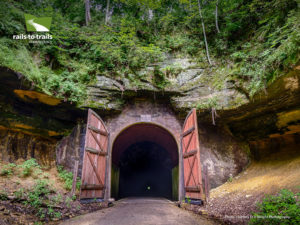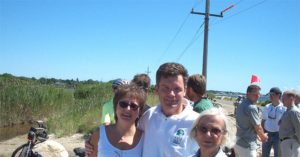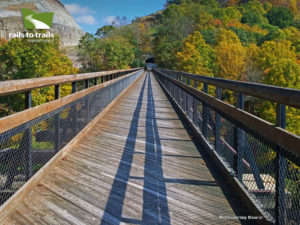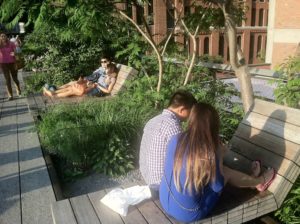R.I.P., Trailblazer David Burwell

For some years, walker and bicyclist friends of mine have talked about outdoor pleasures found along the Baltimore and Annapolis (B&A) Trail running 13 mi. from Annapolis to Glen Burnie, MD. There are 2 stops along the way where food/refreshments can easily be procured. The paved, 8′ wide Trail runs in the roadbed of the old B&A rail line that connected Annapolis to Baltimore. At Glen Burnie, the replacement Baltimore light rail runs into Baltimore City and further to its terminus in Hunt Valley.
The Trail is a part of the East Coast Greenway which runs from FL to ME. Over 30% of this span is traffic-free. ECG was founded in 1991.

 But, the Rails-to-Trails Conservancy (RTC) was co-founded 5 years earlier by David G. Burwell who died 3 weeks ago at age 69.
But, the Rails-to-Trails Conservancy (RTC) was co-founded 5 years earlier by David G. Burwell who died 3 weeks ago at age 69.
Inspiring the vision of RTC was Burwell’s mother (foreground right in a family photo) who successfully campaigned to turn a defunct Cape Cod railway into the 11-mi. Shining Sea Bikeway there.
Burwell and co-founder Peter Harnik became the first to coordinate national efforts to build a network of abandoned rail lines into bicycle and nature walk trails. Burwell was RTC’s president for its first 15 years. Prior to co-founding RTC, he worked on transportation issues for the National Wildlife Federation.
“It was David who turned ‘rails-to-trails’ from an idea with very good potential into a powerful force backed by firm legal standing, true political muscle and undeniable financial backing,” said Harnick in a recently released statement from RTC quoted in The Washington Post. The National Park Service’s National Trail Systems Act of 1968 was a progenitor.
The late Laurance Rockefeller, an environmental activist, championed the launch of RTC with a grant of $75k, calling Burwell “a fireball of energy and determination and talent.”
Among Burwell’s credentials was his 1973 UVA law degree, the training for which he skilfully employed in helping officials of the Interstate Commerce Commission write new regulations making it easier to convert abandoned rail lines to active people trails. Among RTC’s early competitors were the road building industry; and right-of-way ownership issues across jurisdictions. Another credential was his public advocacy guide, The End of the Road: A Citizens Guide to Transportation Problemsolving, published in 1978.
As WaPo writer Matt Schudel says: “In 1991, the conservancy won a major battle with the passage of the Intermodal Surface Transportation Efficiency Act which mandated that a small portion of federal highway funds be reserved for projects other than paved roads. That money helped groups buy old railroad property, rip up the tracks or build new trails alongside existing rail lines.”
“At office functions he could always be found in the corner energetically chatting with the interns. He felt it was his duty to find future leaders and push them towards public service,” said Shin-pei Tsay, Executive Director of the Gehl Institute, in a memoriam piece written 2 weeks ago. Tsai worked as an intern under Burwell at RTC .

“Today, often in conjunction with the National Park Service, the [RTC] has helped build more than 2,000 trails on more than 22,000 miles of rail corridor in all 50 states and the District [of Columbia]. Another 8.000 miles of trails are in the planning stage.”
I like to think of New York City’s The High Line as a rails-to-trails conversion. After all, it was originally designed and used as an elevated freight railway along the Lower West Side of Manhattan. Its inspiration is said to be the Rails-to-Trails Conservancy movement across our land.

Opening Day for Trails, RTC’s 5th annual, occurs on April 8th when people across the country will walk, run, ride or other special event along the trails.